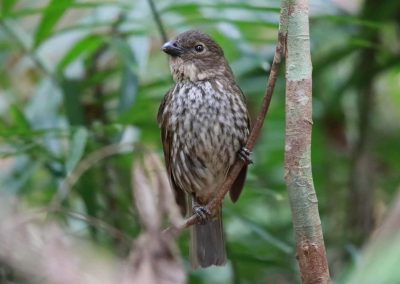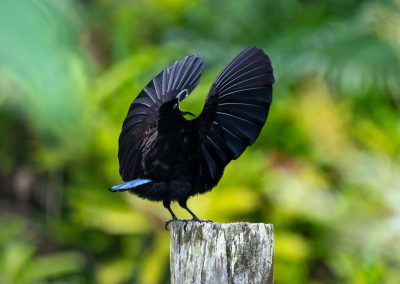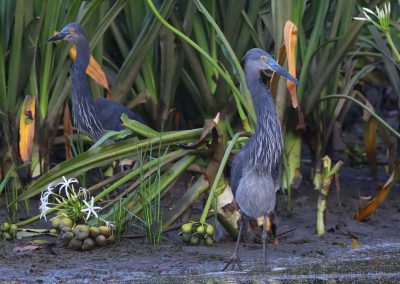Our Birds
Tropical North Queensland is renowned for its incredible birdlife. The bird diversity of the region (about 430 species) is the greatest of any comparable area in Australia and some of most sought-after birds of Australia are found here. Some of these are illustrated below.
The high level of avian diversity and endemism (see ‘Endemics’ page) of North Queensland begins with the Gondwanaland ancestry of some of our birds and has been influenced by subsequent waves of colonisation and isolation in more recent times.
Southern Cassowary
© Birdwatching Tropical Australia
Flightless. Endangered. Possibly our most sought-after species.
Tooth-billed Bowerbird
© Birdwatching Tropical Australia
Clears a ‘display court’ on the rainforest floor for courtship.
In general, the birdlife of Australasia is ancient. The Southern Cassowary is just one example with ancestry dating back before the break-up of the Gondwanaland, with ratite relatives now separated across the southern continents. It is now widely recognised that songbirds originated in Australasia, then dispersed to the rest of the world. In more recent prehistoric times however, a few northern bird families have subsequently colonised Australasia, particularly North Queensland. These families include orioles, drongos, sunbirds, flowerpeckers and night herons. Furthermore, in the very recent past there has been another wave of arrivals. Some like the Cattle Egret have self-colonised whilst others including sparrows, turtle-doves and mynahs have been introduced.
The birdlife of North Queensland is strongly influenced by ties with New Guinea. Each ice age there has been a land bridge between these regions allowing movement of wildlife. Cassowaries, bowerbirds and ‘Birds of Paradise’ (as well as Tree-kangaroos) are prime examples, inhabiting both areas. North Queensland members of the ‘Bird of Paradise’ family include riflebirds and manucode. In recent years, yet another successful colonisation event of North Queensland by a New Guinean bird has occurred with the arrival of Spotted Whistling-ducks.
Buff-br. Paradise-kingfisher
© Dom Chaplin
Excavates nesting chambers within rainforest termite mounds.
Great-billed Heron
© Doug Herrington, Daintree River Wild Watch
A very large heron that sometimes eats small crocodiles.
The birdlife of North Queensland is also influenced by ties to more southerly parts of Australia. Indeed a number of birds reach their northern limits in North Queensland and have developed local subspecies. These tropical forms are often more intensely coloured and smaller than their temperate counterparts. These northern subspecies are most likely to live at higher altitudes in the tropics. Crimson Rosella and Satin Bowerbirds display all these traits. In some cases, where isolation has been extensive, speciation has occurred, with related species occurring in the separate regions, with Chowchilla and Logrunner as examples.
The bird diversity of North Queensland is also enriched by visitation by some migrant species annually. Each spring, a suite of birds migrate from New Guinea to spend the summer in Australasia, particularly North Queensland. These include starlings, imperial-pigeons, cuckoos, monarchs, pittas and Buff-breasted Paradise-kingfisher. Additionally, each spring there are 40 to 50 shorebird species that migrate from the Northern Hemisphere to spend the summer in Australia. There was much excitement in early 2021, when the total bird ‘richness’ of North Queensland rose by one, with the arrival of a Nordmann’s Greenshank on the Cairns Esplanade. This was only the third record for this species in Australia and a first for North Queensland.
Little Kingfisher
© Dean Ingwersen, Daintree Boatman Cruises
World’s second smallest kingfisher. Dives for tiny aquatic life.
Sarus Crane
© Birdwatching Tropical Australia
World’s tallest flying bird. Pairs perform courtship ‘dances’.
Spotted Whistling-duck
© Martin Willis, Daintree Boatman Cruises
A small pretty duck from New Guinea now colonizing North Qld.












